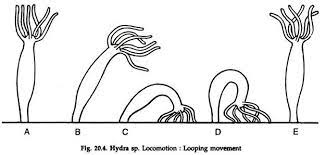What is Hydra Locomotion?
While the hydra remains attached to the substratum, it is able to twist its body and move its tentacles in order to capture its prey.
Sometimes, hydra can move from one point to another by looping and somersaulting with the help of its tentacles.
It can also extend and contract its tentacles very rapidly. It may glide along the substratum by amoeboid movements of pseudopodia given out by certain cells of the foot.
Like I’ve said, the 2 major kinds of movement in hydra are by looping or somersaulting. Here are the ways movement is shown by hydra.
Looping Movement in Hydra
Looping begins when it stretches its body and then bends or in such a way that the tentacles touch the substratum.
By means of sticky cnidoblasts present in the tentacles, the latter are able to adhere to the substratum. At this point, the animal is bent in the shape of a loop.
Next, the foot releases its hold and moves to a new site near the tentacles.
Once it has secured itself in this position, the tentacles release their hold on the substratum and the body assumes an upright position.
By repeating the process, the hydra can move slowly along the substratum. This “walking” resembles the looping action of a leech.
Somersaulting Movement in Hydra
Occasionally, when the body of the hydra is in the looping position, the basal foot of the animal turns a somersault so as to move to a new site on the other side of the tentacles.
These then release their hold on the substratum, after which the body assumes an upright position.
This method of moving is called somersaulting, and hydra moves faster by somersaulting than by looping.
How do Hydras swim
On rare occasions, the hydra is seen floating at the surface of the water.
It obtains its buoyancy by means of a gas bubble secreted by certain cells of the foot.
In this way, it can be carried about passively by means of water currents.
Responsiveness of Hydra
The nervous system of Hydra is very primitive, so that nerve impulses travel through it very slowly.
Hydra is sensitive to the presence of food material, however, if it is well fed, it will not show any response to food material that comes near it.
Hydra avoids both very strong and very weak illumination and usually moves about by trial and error until the most favorable condition is found.
It moves towards cool water and regions of the high oxygen concentration rather than the reverse in each case.
A sight touch causes the part concerned to turn away from the stimulus, but a stronger stimulus results in gradual contraction of both the tentacles and the body, and a bending of the former towards the stimulus.
When extremely irritated, the body contracts to a small spherical blob while the tentacles appear as short projections on the free end.








